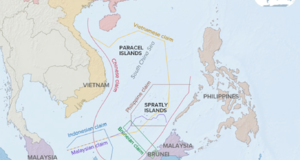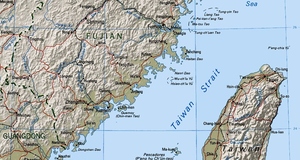From Clocks and Clouds VOL. 7 NO. 1Understanding the Potential for Conflict in the South China SeaPotential and Alternative InterpretationsThis research concludes that economic interdependence plays the single greatest role in constraining the use of force in the South China Sea; however, there are other potential and alternative explanations for the same decline. Data used to analyze China's Charm Offensive would also support constructivist claims that the establishment of regional frameworks (which thus create norms of behavior among states) substantially mitigates the risk of conflict. That said, there are other interpretations among Sinologists and international relations theorists as to how these findings can be interpreted. Most prominent of dissenting interpretations belong to realist scholars. The evidence collected could tentatively support a nuanced interpretation of the offensive realist's argument: that China's vast accumulation of power could have hegemonic, stabilizing effects on the region. Still, the plausibility of such an explanation is hampered by the disputant states' vigorous opposition to China's island reclamation activities, and the increasing role of U.S. naval projection, both of which risk escalating the conflict. Other Sinologists argue that China is using the Charm Offensive and this current period of prolonged economic and diplomatic engagement to cynically bide time for a sustained military buildup and perhaps impending military engagement. Such a buildup would inevitably expand China's growing naval capabilities, which represents a dangerous challenge to U.S. naval primacy, and certainly the security of disputant states (O'Rourke 2016). Data regarding China's military spending and pundit speculation of China's naval ambitions (most notably its pursuit of a second, homegrown aircraft carrier and an increasingly treacherous submarine fleet) would support these claims (Lim 2011; Ross 2009). Such realists allege that China's recent economic parity with the United States and military modernization have allowed China to make the constrained provocations it has in the South China Sea. However, these scholars acknowledge that China is not yet powerful enough to openly engage in a violent conflict over the South China Sea. So long as that remains true, the use of force in the South China Sea will be constrained. However, this interpretation of peace is subject to change should China's military strength— especially relative to the United States and the collective will of ASEAN—rapidly surge. These realists would mostly agree that economic interdependence and regional norms are constraining force for now, but disagree as to whether these factors will continue to hold in the decades to come. ConclusionThe South China Sea will continue to be a contentious nexus for conflict in Southeast Asia for the foreseeable future. At present, there are no clear solutions to the multiple territorial disputes currently at stake. Regional normative frameworks, primarily propagated through Chinese-ASEAN cooperation, has made diplomatic progress, but remain unlikely to permanently constrain China's aggressive provocations. This is supported by conditions surrounding the Philippines' legal challenge to invasive Chinese claims—a step taken through a legal, normative framework which is widely anticipated to be ignored by the Chinese (Permanent Court of Arbitration 2013). At the same time, relative power does not offer a complete explanation either. Growing Chinese military advantages, especially in defense spending, technology, and geographic proximity may have encouraged recent territorial reclamations, but offer no sign of actual use of force. My analysis thus calls into question the supposedly belligerent nature of states which increase their relative power, and identifies possible contradictions in the influence of regional normative frameworks. Of the three variables analyzed, the increasing economic interdependence would appear to have the most constraining influence on the use of force by raising the costs of conflict. This research contributes to an ongoing debate within international relations regarding the factors by which states decide to use force. By identifying economic interdependence as the most plausible constraining influence on the use of force, this research can hopefully provide insight to policymakers regarding the South China Sea and conflict prevention at large. By specifically investigating variables pertinent to prevalent international relations theory, this research can also inform future conflict prevention models. Of course, these findings are subject to methodological limitations. As such, future research regarding the potential for conflict should seek to identify other plausible factors for conflict between states. Such research would have to examine other global hotspots to compare these same variables, and new ones, for explanatory power. Future research specifically focusing on the South China Sea will have to carefully monitor potential normative and economic solutions for a permanent resolution to the territorial dispute. The data that I collected has demonstrated an unquestionable Chinese military advantage that is widely expected to grow over the coming years. However, all parties involved, including China, have indicated a preference against conflict (at least for now), and a long-term, nonviolent solution is viewed to be in everyone's best interest. This combination only makes further research regarding conflict prevention more important. This research can continue to search for and improve operationalization for factors which constrain the use of force. Such research would hopefully help guide security policy into an optimistic future. AuthorBailey Wong is a student of International Studies and Economics. He graduates in May of 2018. School of International Service (SIS) and College of Arts & Sciences (CAS), American University. Email: bw9738a@student.american.edu ReferencesAcharya, Amitav. 1997. "Ideas, Identity, and Institution-Building: From the ‘ASEAN Way' to the ‘Asia-Pacific Way'?" The Pacific Review 10 (3): 319-46. Acharya, Amitav. 2014. "Thinking Theoretically about Asian IR." In International Relations of Asia, edited by David Shambaugh and Michael Yahuda, 68-77. Second edition. Rowman & Littlefield Publishers, Inc. Acharya, Amitav. 2004. "Will Asia's Past Be Its Future?" International Security 28 (3): 149-64. ASEAN Secretariat. 2002. "Declaration on the Conduct of Parties in the South China Sea." Phnom Penh, Cambodia. ASEAN Secretariat. 2008. Charter of the Association of Southeast Asian Nations. Association of Southeast Asian Nations. Barbieri, Katherine and Omar Keshk. 2012. Correlates of War Project Trade Data Set Codebook, Version 3.0. Online: http://correlatesofwar.org. Barbieri, Katherine, Omar M. G. Keshk, and Brian Pollins. 2009. "Trading Data: Evaluating our Assumptions and Coding Rules." Conflict Management and Peace Science, 26 (5): 471-91. Christensen, Thomas. Summer 2006. "Fostering Stability or Creating a Monster? The Rise of China and US Policy Towards East Asia," International Security 31 (1): 81-126. Dolven, Ben, Jennifer K. Elsea, Susan V. Lawrence, Ronald O'Rourke, and Ian E. Rinehart. 2015. Chinese Land Reclamation in the South China Sea: Implications and Policy Options. CRS Report No. R44072. Washington: Congressional Research Service. Doyle, Michael W. 2005. "Three Pillars of the Liberal Peace." American Political Science Review 99 (3): 463-66. Elman, Colin. 2004. "Extending Offensive Realism: The Louisiana Purchase and America's Rise to Regional Hegemony." American Political Science Review 98 (4): 563-76. Fravel, M. Taylor. 2011. "China's Strategy in the South China Sea." Contemporary Southeast Asia 33 (3): 292-319. Fravel, M. Taylor. 2010. "International Relations Theory and China's Rise: Assessing China's Potential for Territorial Expansion." International Studies Review 12 (4): 505-32. Fravel, M. Taylor. 2008. "Power Shifts and Escalation: Explaining China's Use of Force in Territorial Disputes." International Security 32 (3): 44-83. Friedberg, Aaron L. 2011. A Contest for Supremacy: China, America, and the Struggle for Mastery in Asia. New York: W. W. Norton & Company. Friedberg, Aaron L. 2005. "The Future of U.S.-China Relations: Is Conflict Inevitable?" International Security 30 (2): 7-45. George, Alexander L. and Andrew Bennett. 2005. Case Studies and Theory Development in the Social Sciences. Cambridge: The MIT Press. Glaser, Bonnie S. 2012. Armed Clash in the South China Sea. Contingency Planning Memorandum No. 14. Washington: Council on Foreign Relations. Guoqiang, Li. 2015. China Sea Oil and Gas Resources. Beijing: China Institute of International Studies. Haacke, Jürgen. 2003. "ASEAN's Diplomatic and Security Culture: A Constructivist Assessment." International Relations of the Asia-Pacific 3 (1): 57-87. Permanent Court of Arbitration. 2013. "Arbitration between the Republic of the Philippines and the People's Republic of China: Arbitral Tribunal Establishes Rules of Procedure and Initial Timetable." PCA Press Release. The Hague: Permanent Court of Arbitration. Heads of State/Government at the 1st ASEAN Summit. "1976 Treaty of Amity and Cooperation." 1-6. Bali, Indonesia: Association of Southeast Asian Nations, 1976. http://www.icnl.org/research/library/files/Transnational/1976Treaty.pdf. Hendrickson, David C. 1998. "From Wealth to Power: The Unusual Origins of America's World Role." Foreign Affairs 77 (4): 120. Heng, Pek Koon. 2016. Interview by Bailey Wong. In person. American University, Washington D.C. Hunt, Katie, Jim Sciutto, and Tim Hume. 2016. "South China Sea Dispute: China Has Missiles on Island," CNN, 2016. Ikenberry, John. 2011 Liberal Leviathan: The Origins, Crisis, and Transformation of the American World Order. Princeton: Princeton University Press. Ikenberry, G. John. 2013. "The Rise of China, the United States, and the Future of the Liberal International order," in Tangled Titans, edited by David Shambaugh. Lanham: Rowman and Littlefield. International Monetary Fund. Balance of Payments Compilation Guide. IMF Publication, 1995. Asia Maritime Transparency Initiative. 2016. "Island Tracker." Asia Maritime Transparency Initiative. Johnson, Alastair I. 2007. Social States: China in International Institutions, 1980-2000. Princeton: Princeton University Press. Junguo, Liu. 2012. "China Becomes Japan's Largest Trading Partner for Five Consecutive Years," People's Daily Online, February 21, 2012. Kang, David C. 2003. "Getting Asia Wrong: The Need for New Analytical Frameworks." International Security 27 (4): 57-85. Kaplan, Robert. 2009. "Center Stage for the 21st Century: Power Plays in the Indian Ocean," Foreign Affairs, 88 (2): 20. Karim, Azhari. 2007. "ASEAN: Association to Community: Constructed in the Image of Malaysia's Global Diplomacy," in Malaysia's Foreign Policy: Continuity and Change, edited by Abdul Razak Baginda, 109-132. Singapore: Marshal Cavendish Editions. Kent, Ann. 2007. Beyond Compliance: China, International Organizations, and Global Security. Stanford: Stanford University Press. Kurlantzick, Joshua. 2006. China's Charm Offensive in Southeast Asia. Washington: Carnegie Endowment for International Peace. Labs, Eric J. 1997. "Beyond Victory: Offensive Realism and the Expansion of War Aims." Security Studies 6 (4): 1-49. Li, Xiaoting. 2013: "The Taming of the Red Dragon: The Militarized Worldview and China's Use of Force, 1949-2001." Foreign Policy Analysis 9 (4): 387-407. Liff, Adam P. and Andrew S. Erickson. 2013. "Demystifying China's Defense Spending: Less Mysterious in the Aggregate." The China Quarterly 216 (216): 805-30. Lim, Yves-Heng. 2011. "The Driving Forces behind China's Naval Modernization." Comparative Strategy 30 (2): 108-14. Ma, Gac. 2013. ""The Circle of Immortality" On The Beach Gac Ma," Tuổi Trẻ Online. http:// tuoitre.vn/tin/chinh-tri-xa-hoi/phong-su-ky-su/20130309/vong-tron-bat-tu-tren-baigacma/537171.html. Mearsheimer, John J. Winter 1994-95. "The False Promise of International Institutions." International Security 19 (3): 5-49. Mearsheimer, John J. 2001. The Tragedy of Great Power Politics. New York: W. W. Norton & Company. Medeiros, Evan. Winter 2005-06. "Strategic Hedging and the Future of Asia-Pacific Stability." Washington Quarterly 29 (1): 145-67. Minh, H.E. Le Luong. 2013. "Special Remarks by H.E. Le Luong Minh, Secretary-General of ASEAN." In ASEAN and the South China Sea: Issues, Progress and Future Prospects, 1-10. Phnom Penh: Association of Southeast Asian Nations. Morgenthau, Hans. 2005. Politics Among Nations: The Struggle for Power and Peace. New York: McGraw-Hill Education. Nathan, Andrew J. and Andrew Scobell. Sep.-Oct. 2012. "How China Sees America: The Sum of Beijing's Fears." Foreign Affairs 91 (5): 32-47. The New York Times. 1974. "23 Vietnamese Survivors of Sea Battle Are Found." The New York Times, January 23, 1974. Nischalke, Tobias Ingo. 2000. "Insights from ASEAN's Foreign Policy: The "ASEAN Way", a Real Spirit or a Phantom?" Contemporary Southeast Asia 22 (1): 89-112. O'Rourke, Ronald. 2016. China Naval Modernization: Implications for U.S. Navy Capabilities— Background and Issues for Congress. CRS Report No. RL33153. Washington: Congressional Research Service. Palmer, Glenn, Vito D'Orazio, Michael Kenwick, and Matthew Lane. 2015. "The MID4 Data Set: Procedures, Coding Rules, and Description." Conflict Management and Peace Science 32 (2): 222-42. Pempel, T.J. 2005. "Introduction: Emerging Webs of Regional Interconnectedness," in Remapping East Asia: Construction of a Region, edited by T.J. Pempel, 1-30. Ithaca: Cornell University Press. Perlez, Jane. 2016. "U.S. Challenges China's Claim of Islands with Maritime Operation," The New York Times, January 30, 2016. Permanent Mission of the People's Republic of China to the United Nations. China's Position Paper on the New Security Concept, n.d. http://www.china-un.org/eng/xw/t27742.htm. Republic of the Philippines Department of Foreign Affairs. 2013. "Notification and Statement of Claim No. 13-0211." Manila. https://seasresearch.wordpress.com/2014/12/17/2nd-press-releasefrompca-the-arbitral-tribunal-sets-further-proceedings/. Ross, Robert S. 2009. "China's Naval Nationalism." International Security 34 (2): 68-72. Roy, Denny. 1996. "The "China Threat" Issue: Major Arguments." Asian Survey 36 (8): 758-71. Shipler, David K. 1974. "Saigon Says Chinese Control Islands, but Refuses to Admit Complete Defeat," The New York Times, January 21,1974. Shiraev, Eric B. 2014. International Relations. New York: Oxford University Press. Singer, J. David. 1987. "Reconstructing the Correlates of War Dataset on Material Capabilities of States, 1816-1985." International Interactions, 14 (2): 115-32. Singer, J. David, Stuart Bremer, and John Stuckey. 1972. "Capability Distribution, Uncertainty, and Major Power War, 1820-1965." In Peace, War, and Numbers, edited by Bruce Russett, 1948. Beverly Hills: Sage. Slaughter, Anne-Marie. 2011. "International Relations, Principal Theories." In Max Planck Encyclopedia of Public International Law, edited by Rüdiger Wolfrum. Oxford: Oxford University Press. Sutter, Robert. 2006. China's Rise: Implications for US Leadership in Asia. Washington: East-West Center. Tellis, Ashley J. "Overview: The United States and Asia's Rising Giants." In Asia Responds to its Rising Powers: China and India, edited by Ashley J. Tellis, Travis Tanner, and Jessica Keough, 4-32. Washington: The National Bureau of Asian Research. Tellis, Ashley J., Janice Bially, Christopher Layne, and Melissa McPherson. 2000. Measuring National Power in the Postindustrial Age. Santa Monica: RAND Corporation. Tellis, Ashley J. 2012. "U.S.-China Relations in a Realist World." In Tangled Titans, edited by David Shambaugh, 75-102. First edition. Lanham: Rowman & Littlefield Publishers, Inc. Thayer, Carlyle A. 2015. "ASEAN and the South China Sea: A Dual Track Approach?" Paper presented at the High-Level International Workshop Managing South China Sea Conflict from ASEAN Perspective. Jakarta, Indonesia. Thayer, Carlyle A. 2012. "ASEAN's Code of Conduct in the South China Sea: A Litmus Test for Community-Building." The Asia-Pacific Journal 10 (34): 1-22. Torbati, Yeganeh. 2015. "'Hope to See You Again': China Warship to U.S. Destroyer After South China Sea Patrol." Reuters, November 6, 2015. VanEvera, Stephen. 1997. Guide to Methods for Students of Political Science. Ithaca: Cornell University Press. Vasquez, John A. 1993. The War Puzzle. New York: Cambridge University Press. Waltz, Kenneth N. 1979. Theory of International Politics. Reading: Addison-Wesley Pub. Co. Wang, Jamie and Lin Shu-yuan. 2013. "U.S. Report Details Rich Resources in South China Sea." Focus Taiwan News Channel, February 9, 2013. Wendt, Alexander. 1999. Social Theory of International Politics. Cambridge: Cambridge University Press. Wendt, Alexander. 1995. "Constructing International Politics." International Security 20 (1): 71-81. World Bank. 2016. World Development Indicators: GDP at Market Prices (Current US$) China. The World Bank Group. World Bank. 2016. World Development Indicators: Military Expenditure (% of GDP) China. The World Bank Group. Zhao, Suisheng. 2013. "Foreign Policy Implications of Chinese Nationalism Revisited: The Strident Turn." Journal of Contemporary China 22 (82): 535-53. Zhou Enlai Waijiao Wenxuan 1990. Zhou Enlai's Selected Works on Diplomacy. Beijing: Zhongyang wenxian chubanshe. Endnotes
AppendixTable 1A: Dependent Variable 1—Relative Power Table 2A: Dependent Variable 2—Regional Normative Frameworks Suggested Reading from Inquiries Journal
Inquiries Journal provides undergraduate and graduate students around the world a platform for the wide dissemination of academic work over a range of core disciplines. Representing the work of students from hundreds of institutions around the globe, Inquiries Journal's large database of academic articles is completely free. Learn more | Blog | Submit Latest in International Affairs |



















